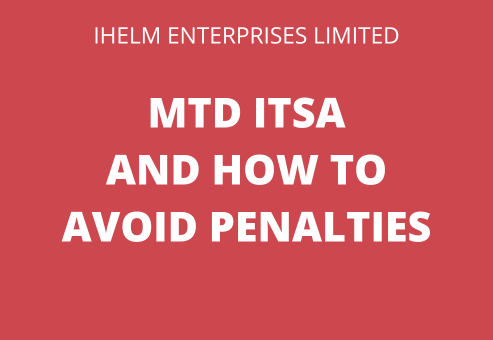During June’s Facebook Live, I discussed the penalties you could receive if you do not follow MTD ITSA regulations, and how to avoid them.
From April 2026, UK sole traders and landlords will have to start submitting their accounts information to HMRC every quarter, under Making Tax Digital for Income Tax and Self-Assessment. Failure to follow the regulations correctly could lead you to receive penalties and fines.
What is MTD ITSA?
MTD ITSA is HMRC’s initiative to digitise the tax reporting process for self-employed individuals and landlords. It is designed to make the UK tax system more effective, efficient and easier for taxpayers.
It is going to be a gradual process for those who have to start following MTD ITSA. Sole Traders and Landlords with an income over £50,000 will need to follow MTD ITSA from April 2026. Those with an income of over £30,000 from April 2027, and those with an income of over £20,000 from April 2028. At this point in time, no announcements have been made about partnerships or limited companies.
Overview of Penalties for MTD ITSA
There is a new penalty system put in place by HMRC to support MTD ITSA, which has been designed to encourage sole traders and landlords to comply with MTD ITSA regulations. It includes ensuring they are keeping accurate digital records, sending submissions on time, and making sure their accounts are accurate. Understanding the associated penalties is crucial to ensure compliance and avoid unexpected fines. The penalty system for MTD ITSA is separate from the penalty system for MTD VAT. If you are VAT registered and also have to file under MTD ITSA, if you incur penalties for MTD VAT, these will not affect your penalties for MTD ITSA and vice versa.
There are several components to the MTD ITSA penalty system:
- Late Submission Penalties
- Late Payment Penalties
- Specific Penalties for Record-Keeping Failures
Let’s look at each of the penalty systems.
Late Submission Penalties
Late Submission Penalties are applied when a return has been submitted after the deadline, both the quarterly updates and the final declaration at the year-end. For every late submission, you will receive 1 penalty point. Once you have reached the threshold of penalty points allowed, you will receive a fine of £200.00.
The threshold of points is dependent on the submission frequency. For quarterly submissions, the threshold is 4 points, and for annual submissions like the Final Declaration, it is 2 points. That means if you accumulate 4 points for late quarterly submissions, you will receive a fine of £200.00. For every subsequent late submission once you’ve reached the points threshold, you will be issued a further £200.00 fine.
If you have more than one business that needs to follow MTD ITSA, you will be required to file 2 separate quarterly updates and two separate Final Declarations. The submissions will contribute to a single penalty point per quarter. For example, if you submit both quarterly updates late, you would only receive one penalty point for the quarter.
The penalty points do expire after a certain time period and will reset to zero. If you have accumulated penalty points, but have not reached the threshold, the points automatically expire after two years. It is important to note that the two-year period starts from the month after you have received the points. For example, if you receive a penalty point in May, the two-year period would start from June.
Once you have reached the point threshold, in order for the points to expire, you need to maintain a “period of compliance” before the points are removed from your records. The “period of compliance” depends on the frequency of the return submissions. During the “period of compliance”, you cannot have any further late submissions. For Annual Submissions (the Final Declaration), it is a period of 24 months, and for quarterly submissions, it is 12 months. Not only do you need to ensure you file all submissions correctly and on time, but all outstanding submissions from the previous 24 months must also be filed. Once both conditions have been met, your accumulated points will reset to zero.
Late Payment Penalties
If you are late making a payment for your tax that’s due, you will be charged interest, and the amount depends on how overdue the payment is.
For the first 15 days after the payment was due, no interest will be levied. However, if the payment is 16 days or more late, that is when you will be charged interest. For payments that are between 16 and 30 days late, there will be 2% penalty charged on the outstanding tax amount. For payments that are 31 days or more late, you will be charged an additional 2% of the outstanding tax due as of day 30, and then a daily accruing interest charge of 4% annually.
Other Types of Penalties
There are other penalties that can be levied by HMRC in relation to MTD ITSA.
This includes:
- A fine of up to £400 per return submitted through non-MTD-compatible Software (including using spreadsheets without MTD-compatible bridging software)
- If you aren’t keeping proper digital records, you will usually be issued with a written warning the first time, but for those who repeatedly fail to keep the proper records, a fine of up to £3,000 per failure for each tax period could be levied. This isn’t a fine that is issued automatically. It is for more serious cases.
- If you are failing to use digital links, ie. You are manually re-keying or copy and pasting data between systems, which breaks the digital journey; you could be fined anywhere between £5 and £15 per day
- If there are inaccuracies in the Final Declaration that lead to an understatement of your tax liability, a percentage of the lost revenue, anywhere from 0% to 100%, could be levied and is dependent on the cause of the inaccurate information
The fines and penalties could quickly add up if multiple infractions are committed. For example, not keeping your records properly could lead to late quarterly submissions and an inaccurate final declaration.
Can a business appeal the penalties?
Like with any penalty HMRC issues, penalties and fines for MTD ITSA can be appealed. There is no guarantee that HMRC will waive the penalties, but if you believe you have received them unfairly or have extenuating circumstances, you can use the reviews and appeals process.
How to avoid getting penalties for MTD ITSA
So, what can you do to avoid receiving penalty points or fines in relation to MTD ITSA?
There are a number of things that you, as a business owner, and your bookkeeper or accountant can do to ensure you do not receive penalty points or fines.
- Ensure that you enrol for MTD ITSA at the right time; If your income from self-employment and/or rental income meets the threshold of £50,000 in April 2026, make sure you are following MTD ITSA from April 2026 and filing your quarterly returns on time.
- Ensure that the software being used for your accounts is MTD Compliant, or any bridging software that is being used is MTD Compliant
- Maintain your accounts on a regular monthly basis so that the quarterly returns and the Final Declaration can be submitted to HMRC on time
- Make sure that your digital records are being kept properly and that all the correct information is being stored
By following these simple steps and keeping on top of your accounts, you will be able to mitigate the penalties you could face for not following the MTD ITSA regulations.
The introduction of MTD ITSA by HMRC is going to cause a significant change in how businesses report their income to HMRC. Businesses that meet the thresholds will no longer be able to submit their information just once a year or be able to use software provided by HMRC. By understanding the new penalty structure that makes up part of the MTD ITSA regulations, business owners will be able to avoid unnecessary fines. By staying informed and starting to make changes to how your accounts are kept now, business owners will be able to navigate the transition smoothly and maintain compliance. Avoid a last-minute scramble and stay one step ahead of the curve.
If you have any questions about penalties for MTD ITS, please feel free to email me.

